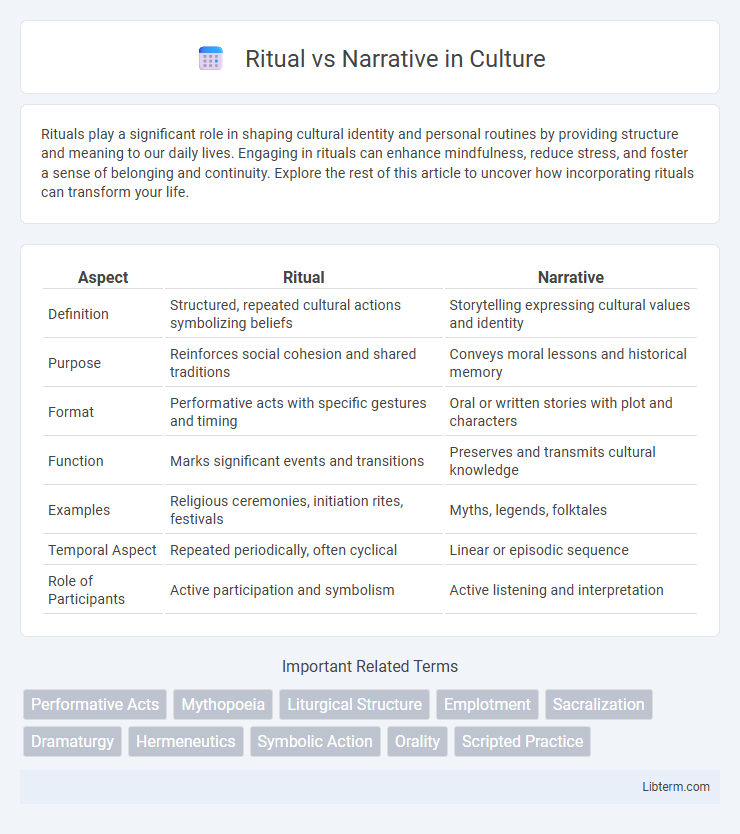Rituals play a significant role in shaping cultural identity and personal routines by providing structure and meaning to our daily lives. Engaging in rituals can enhance mindfulness, reduce stress, and foster a sense of belonging and continuity. Explore the rest of this article to uncover how incorporating rituals can transform your life.
Table of Comparison
| Aspect | Ritual | Narrative |
|---|---|---|
| Definition | Structured, repeated cultural actions symbolizing beliefs | Storytelling expressing cultural values and identity |
| Purpose | Reinforces social cohesion and shared traditions | Conveys moral lessons and historical memory |
| Format | Performative acts with specific gestures and timing | Oral or written stories with plot and characters |
| Function | Marks significant events and transitions | Preserves and transmits cultural knowledge |
| Examples | Religious ceremonies, initiation rites, festivals | Myths, legends, folktales |
| Temporal Aspect | Repeated periodically, often cyclical | Linear or episodic sequence |
| Role of Participants | Active participation and symbolism | Active listening and interpretation |
Understanding Rituals: Definition and Purpose
Rituals are structured, symbolic actions performed routinely to convey meaning, establish social cohesion, and reinforce cultural values. Unlike narratives, which are verbal or written stories that communicate experiences or lessons, rituals engage participants physically and emotionally through prescribed behaviors and ceremonies. Understanding rituals involves recognizing their role in marking transitions, expressing collective identity, and maintaining social order across diverse cultures.
Defining Narratives: Meaning and Significance
Narratives are structured stories that convey meaning by organizing events and experiences into a coherent sequence, allowing individuals and communities to interpret their reality. They serve as frameworks for understanding identity, history, and cultural values, providing significance beyond mere facts. Through symbolic language and shared themes, narratives shape collective memory and guide social behavior.
Key Differences Between Ritual and Narrative
Ritual involves repetitive and symbolic actions performed within a specific cultural or religious context, emphasizing physical enactment and communal participation. Narrative centers on the structured telling of stories, focusing on temporal sequencing, characters, and plots to convey meaning and share experiences. While rituals create shared identity through lived experience, narratives primarily transmit knowledge and values through language and imagination.
The Role of Rituals in Culture and Society
Rituals play a crucial role in culture and society by reinforcing shared values, social cohesion, and collective identity through repeated symbolic actions. Unlike narratives, which provide a linear and interpretive framework to understand experiences, rituals embody cultural norms and beliefs in embodied, performative practices that strengthen communal bonds. Rituals often mark important life transitions, religious observances, and social ceremonies, serving as tangible expressions of cultural continuity and societal structure.
Narratives as Vehicles for Meaning and Memory
Narratives serve as powerful vehicles for meaning and memory by organizing experiences into coherent storylines that enhance understanding and retention. They facilitate the transmission of cultural values, historical events, and personal identities across generations through structured storytelling. By engaging cognitive and emotional processes, narratives embed memories deeply within individuals and communities, ensuring lasting impact.
How Rituals Shape Collective Identity
Rituals play a crucial role in shaping collective identity by reinforcing shared values, beliefs, and social norms through repeated symbolic actions attended by community members. These ceremonies create a sense of belonging and continuity, embedding collective memories that distinguish group identity over time. Unlike narratives, which convey identity through stories and interpretations, rituals enact identity, making abstract social bonds tangible and experiential.
Narrative’s Influence on Personal and Social Beliefs
Narratives shape personal and social beliefs by providing structured stories that convey values, experiences, and shared meanings, deeply influencing identity and cultural norms. Through storytelling, individuals interpret their realities and communities establish collective memory, reinforcing group cohesion and guiding social behavior. This narrative-driven process becomes a powerful tool for shaping moral frameworks and sustaining tradition across generations.
Interplay Between Ritual and Narrative
Rituals provide a structured format for enacting narratives, embedding stories within symbolic actions that reinforce cultural values and collective memory. Narratives shape the meaning and significance of rituals by offering interpretive frameworks that deepen participants' understanding and emotional engagement. The interplay between ritual and narrative creates a dynamic process where stories are both performed and perpetuated, sustaining identity and social cohesion across generations.
Modern Examples: Rituals and Narratives in Contemporary Life
Modern examples of rituals include daily social media check-ins and fitness routines, which provide structure and meaning to contemporary life. Narratives manifest through podcasts, TV series, and social media storytelling, shaping cultural identity and shared experiences. Both rituals and narratives function as tools for community building and personal expression in the digital age.
The Continuing Relevance of Ritual and Narrative
Ritual and narrative continue to play crucial roles in shaping cultural identity and social cohesion by providing frameworks for meaning and shared experience. Rituals anchor communities through repetitive, symbolic actions that reinforce values, while narratives offer dynamic, evolving stories that contextualize those values across time. Together, they maintain relevance by addressing contemporary needs for belonging and understanding in an increasingly fragmented world.
Ritual Infographic

 libterm.com
libterm.com